Cichlid aggression, it gives them so much personality. But, oh boy, it can be a big problem in your aquarium if you don’t manage it correctly.
- Are your oscars biting chunks out of each other?
- Does your midas kill everything it sees?
- Are your angel fish picking on each other?
- Has your male cichlid attacked and/or killed the female in the tank?
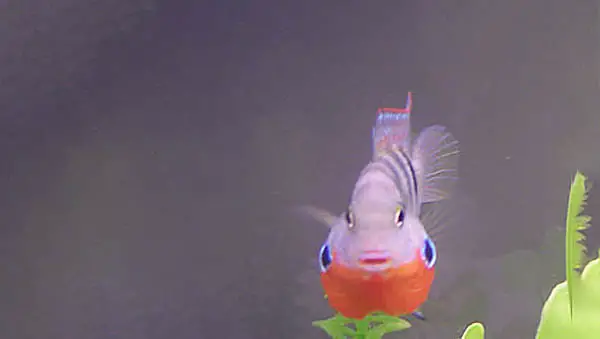
By Figuero32, CC BY 3.0, https://commons.wikimedia.org/w/index.php?curid=6867525
Well, in this article I want to talk about the value of aquascaping or re-scaping—i.e. decorating or redecorating—your fish tank as a way of managing aggression between cichlids.
Aggression Differs Depending On The Species Of Cichlid
Not all cichlids are the same, but they are territorial to a degree. Angel fish and discus might only be territorial when they’ve paired up and chosen a breeding spot, but Central American bruisers like midas cichlids are mean year round. And let’s not even get into how ruthless mbuna can be.
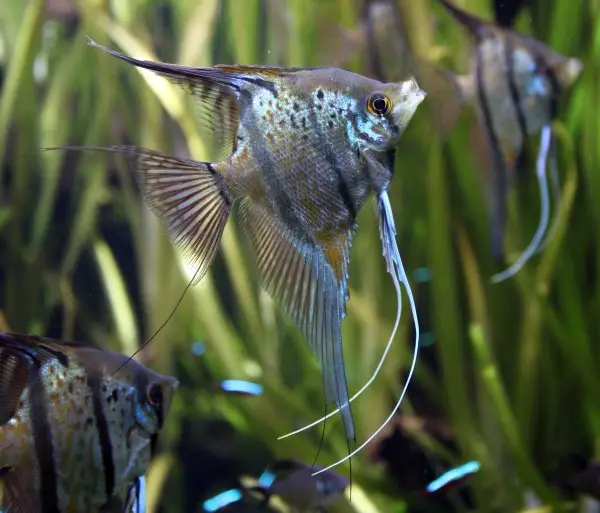
By © Citron, CC BY-SA 3.0,
https://commons.wikimedia.org/w/index.php?curid=31199216
Mixing Cichlid Species Can Be Challenging
You want to keep multiple cichlids together? Maybe mixing species is your thing? Or you might want to mix fish from different locations? Malawi, Tanganyikan, Central American, South American…? Well, it’s difficult.
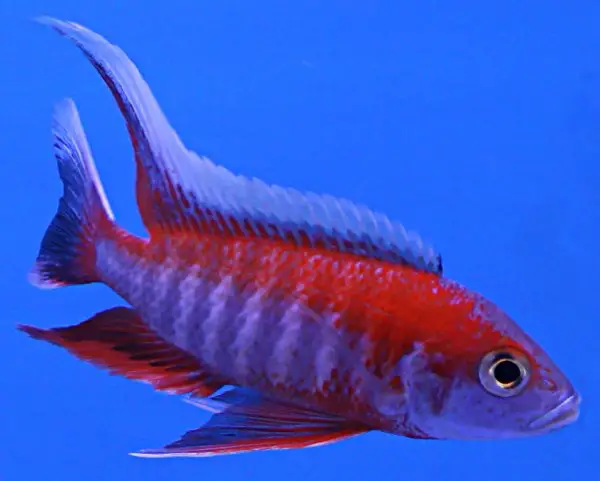
By Lerdsuwa – (400D + 50/1.4), CC BY-SA 3.0,
https://commons.wikimedia.org/w/index.php?curid=1789987
Use Your Aquarium’s Layout To Your Advantage
In my experience, the best tool you have in the fight against cichlid aggression is the aquarium setup itself. The environment you create for your fish, the aquascape, can be used to diffuse aggression.
Clever Use Of Caves
A cave to you might just look cool. Meanwhile, to a cichlid, a cave represents a priceless piece of real estate to be defended valiantly. Careful though, because that’s only for cave breeding cichlids, e.g. some of the South American dwarfs, and West African dwarfs.
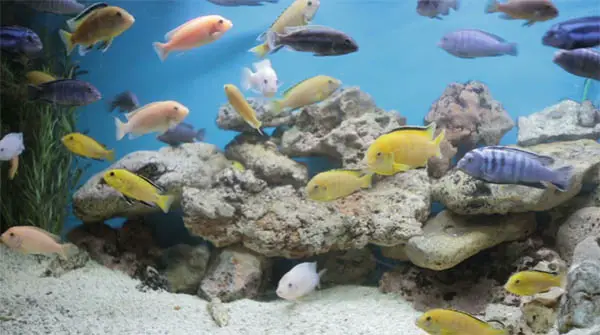
Fun With Flat Rocks
Meanwhile, a flat rock is the prime choice for lots of substrate spawners. Fish like oscars, severums, and red devils all like a nice flat rock on the bottom of the tank. So, bear in mind that if you keep substrate spawners, they might dig in their heels—I mean fins—and fight to the death for a large, smooth cobble that you just thought was a nice centerpiece in the tank. A piece of slate is a good choice. People will often use dinner plates or terracotta plant pot saucers as a substitute.
Some Cichlids Like Upright Nesting Sites
Angel fish and discus prefer to lay eggs on a vertical surface. Upright drift wood, filter pipes, and plant leaves are their preferred spots. But, failing their availability, they’ll even lay eggs directly on the glass.

https://commons.wikimedia.org/w/index.php?curid=37791048
Discus like to spawn on upright surfaces. You can buy purpose made spawning cones off Amazon. Check them out here (affiliate link).
So, Think Ahead When Your Arrange Your Aquarium
So, when you arrange your tank try to predict how your fish will interact with your decorations rather than simply how much you like the aesthetic. In my experience, healthy cichlids will always find a way to breed. So, it’s often best to provide many breeding spots for the different fish in your tank to claim.
Excellent Parents Don’t Make For Excellent Community Fish
Now, having said that, we have to be prepared for the increased aggression that ensues once cichlids have paired up and chosen a breeding site. A breeding pair of cichlids might defend their eggs at one end of your tank. Meanwhile, the rest of the tank’s stock will be huddled in the opposite corner.

https://commons.wikimedia.org/w/index.php?curid=36213766
Severums are fairly peaceful cichlids. But, like angelfish & discus, they show some aggression. Check out the red on this severum! Red is a color often brought out by diet. Check out this article on some of my favorite foods to bring out the best in your fish.
Out Of Sight, Out Of Mind – Use “Line of Sight”
There is a solution to this, and that is “line of sight”. You want to use your decoration to create places where fish can go to be out of sight of a fish chasing them. We love our fish, but they’re not that smart, are they? Object permanence isn’t their strong suit. So usually when an angry parent cichlid chases another fish, it will simply relent once the fish is out of view.
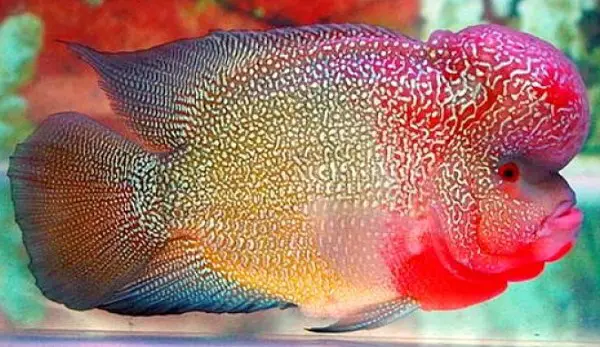
Sometimes its best to just keep an aggressive fish alone. For example, many flowerhorns are kept as single fish in a tank. Flowerhorns are a hybrid cichlid, check out this article on the different techniques used to produce colorful ornamental fish.
Creating blocks to the line of sight can save a fish’s life—it is the difference between a relentless pursuit, where one fish pecks and hounds its target to death, and a momentary rush to chase it a few inches out of sight.
Breeding Cichlids Even Represent A Danger To Themselves
Managing aggression between a bonded pair of cichlids is a challenge too. While it’s more often the male attacking the female, sometimes the reverse can be true and the female can kill the male.
When it comes to dealing with this, a lot of the same concepts apply. Give the female a hiding spot that is big enough for her to hide in, but too small for the male to get inside of.

Line of sight management can help too, but its value is limited in a bonded pair because even though one parent might get angry at the other parent and chase it away, the target parent will inevitably return to the nesting spot to defend it. Even if their partner is being overly aggressive.
Breakups Can Be Tough, But Sometimes It’s For The Best
In cases where a pair of parents aren’t getting along, there might come a time when you need to intervene for the safety of the fish. You can insert a divider in the tank, lots of these allow the male and female to see each other but not get to each other. This prevents their pair bond from being broken, while also preventing violence. Another alternative is to remove the eggs or fry and raise them in a separate tank. Usually in this case the pair will wait a short while before spawning again.
Cichlids And Random Acts Of Violence
The last thing I want to talk about is a common issue—“everything was fine, and then all of a sudden all my fish are fighting”. You can address this by doing a “re-scape”. This means rearranging the entire tank. This will shake up the status quo in the tank, removing territories previously protected by particular fish, and giving them all new territories to establish.

CC BY-SA 3.0, https://commons.wikimedia.org/w/index.php?curid=3939752
Even some peaceful cichlids, like this krib, remain mercurial in personality.
Conclusion
This piece has discussed the toolset available to you for managing cichlid aggression. If you’re having problems keeping your fish in relative harmony, then by all means experiment with all of the methods mentioned here. Discuss the problem with your fellow fishkeepers, try anything and everything you can. However, it’d be silly for me to omit the ultimate solution: sometimes the best solution is to just separate the fish to save a life. Sometimes no matter what you try, a fish is just too aggressive or it just doesn’t like the tank mates you want it to like.
Helping Your Cichlids THRIVE
Keeping aggression down between your fish is an important part of helping your fish thrive. But, even more important is feeding them a quality food. I’ve put together a list of some of my favorite fish foods – check it out here.



